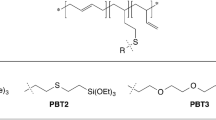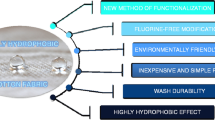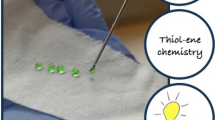Abstract
In this paper, several methods of hydrophobization of cotton fabrics using the thio-ene click reaction were compared. Durable, superhydrophobic textiles were obtained in an easy way. Various variants of functionalized silsesquioxanes were used for the hydrophobization of fabrics. The synthesis of bifunctional silsesquioxanes (RSiMe2O)4(ViSiMe2O)4Si8O12 and (RSiMe2O)4(R’SiMe2O)4Si8O12 were performed via hydrothiolation of silsesquioxane derivative (ViSiMe2O)8Si8O12. Alkoxysilyl, alkyl and fluoroalkyl moieties were introduced as functional groups. Samples were prepared using four methods, differing in the modification method and the number of stages. During the research, fabrics were modified via (a) the dip-coating process, (b) carrying out thiol-ene click reactions directly on the surface of the fabric and (c) using both of these methods. The hydrophobicity of the fabric was evaluated by measuring the Water contact angle (WCA). The obtained samples were also examined using infrared analysis (FT-IR), Scanning electron microscope (SEM), and Elemental analysis (SEM–EDS). All analyses were performed before and after the washing process in order to verify the stability of the performed modifications.
Graphical abstract






modified by silsesquioxanes in Method 1 and Method 2 (Fig. 2.)


modified by 3-mercaptopropyltrimethoxysilane (M) via dip-coating process, then by POSS with vinyl groups (thiol-ene click reaction) (1) and finally by fluoro-funcionalized thiol (F) or octanethiol (C) (thiol-ene click reaction) and values of samples modified by POSS with 4 vinyl groups and substituted by 4 alkoksysilyl group (2c) va dip coating and subsequently modified by fluoro-funcionalized thiol (F) or octanethiol (C) via thiol-ene click reaction





Similar content being viewed by others
Data availability
Data available on request due to privacy restrictions. The data presented in this study are available on request from the corresponding author. The data are not publicly available due to the lack of availability of a suitable repository.
References
Alvarado-Tenorio B, Romo-Uribe A, Mather PT (2013) Nanoscale anisotropic orientation in shape memory random POSS/Polycaprolactone nanocomposites. In MRS symposium proceedings. https://doi.org/10.1557/opl.2013.1117
Chen S, Li X, Li Y, Sun J (2015) Intumescent flame-retardant and self-healing superhydrophobic coatings on cotton fabric. ACS Nano 9:4070–4076. https://doi.org/10.1021/acsnano.5b00121
Chen X, Zhou Q, Zhang Y, Zhao J, Yan B, Tang S, Xing T, Chen G (2020) Fabrication of superhydrophobic cotton fabric based on reaction of thiol-ene click chemistry. Colloids Surf A Physicochem Eng Asp 586:124175. https://doi.org/10.1016/j.colsurfa.2019.124175
Dias Filho NL, Aquino HAD, Pires G, Caetano L (2006) Relationship between the dielectric and mechanical properties and the ratio of epoxy resin to hardener of the hybrid thermosetting polymers. J Braz Chem Soc 17:533–541. https://doi.org/10.1590/S0103-50532006000300016
Duszczak J, Mituła K, Januszewski R, Żak P, Dudziec B, Marciniec B (2019) Highly efficient route for the synthesis of a novel generation of tetraorganofunctional double-decker type of silsesquioxanes. ChemCatChem 11:1086–1091. https://doi.org/10.1002/cctc.201801609
Fang Y, Liu C, Li M, Miao X, Pei Y, Yan Y, Xiao W, Wu L (2020) Facile generation of durable superhydrophobic fabrics toward oil/water separation via thiol-ene click chemistry. Ind Eng Chem Res 59:6130–6140. https://doi.org/10.1021/acs.iecr.9b06761
Ferrero F, Periolatto M (2013) Application of fluorinated compounds to cotton fabrics via sol-gel. Appl Surf Sci 275:201–207. https://doi.org/10.1016/j.apsusc.2013.01.001
Gao Y, Eguchi A, Kakehi K, Lee YC (2004) Efficient preparation of glycoclusters from silsesquioxanes. Org Lett 6:3457–3460. https://doi.org/10.1021/ol040043a
Hou K, Zeng Y, Zhou C, Chen J, Wen X, Xu S, Cheng J, Pi P (2018) Facile generation of robust POSS-based superhydrophobic fabrics via thiol-ene click chemistry. Chem Eng J 332:150–159. https://doi.org/10.1016/j.cej.2017.09.074
Hoyle CE, Bowman CN (2010) Thiol–ene click chemistry. Angew Chem Int Ed 49:1540–1573. https://doi.org/10.1002/anie.200903924
Karuppasamy K, Prasanna K, Vikraman D, Kim HS, Kathalingam A, Mitu L, Rhee HW (2017) A rapid one-pot synthesis of novel high-purity methacrylic phosphonic acid (PA)-based polyhedral oligomeric silsesquioxane (POSS) frameworks via thiol-ene click reaction. Polymers 9:192. https://doi.org/10.3390/polym9060192
Li Y, Dong XH, Guo K, Wang Z, Chen Z, Wesdemiotis C, Quirk RP, Zhang WB, ChengSZD, (2012) Synthesis of shape amphiphiles based on POSS tethered with two symmetric/asymmetric polymer tails via sequential “grafting-from” and thiol–ene “click” chemistry. ACS Macro Lett 1:834–839. https://doi.org/10.1021/mz300196x
Li L, Xue L, Feng S, Liu H (2013) Functionalization of monovinyl substituted octasilsesquioxane via photochemical thiol-ene reaction. Inorganica Chim Acta 407:269–273. https://doi.org/10.1016/j.ica.2013.08.009
Li Y, Guo K, Su H, Li X, Feng X, Wang Z, Zhang W, Zhu S, Wesdemiotis C, Cheng SZD, Zhang WB (2014) Tuning “thiol-ene” reactions toward controlled symmetry breaking in polyhedral oligomeric silsesquioxanes. Chem Sci 5:1046–1053. https://doi.org/10.1039/C3SC52718B
Li H, Dai J, Xu Q, Lu C, Yang G, Wang F, Nie J, Hu X, Dong N, Shi J (2019) Synthesis of thiol-terminated PEG-functionalized POSS cross-linkers and fabrication of high-strength and hydrolytic degradable hybrid hydrogels in aqueous phase. Eur Polym J 116:74–83. https://doi.org/10.1016/j.eurpolymj.2019.03.062
Lin TC, Lee DJ (2021) Cotton fabrics modified for use in oil/water separation: a perspective review. Cellulose. https://doi.org/10.1007/s10570-021-03850-6
Liu L, Liu Z, Huang P (2016) Novel POSS based nanohybrids for improving tribological properties of liquid paraffin. RSC Adv 6:94876–94883. https://doi.org/10.1039/C6RA21618H
Lowe AB (2014) Thiol–ene “click” reactions and recent applications in polymer and materials synthesis: a first update. Polym Chem 5:4820–4870. https://doi.org/10.1039/C4PY00339J
Maciejewski H, Karasiewicz J, Dutkiewicz M, Marciniec B (2015) Hydrophobic materials based on fluorocarbofunctional spherosilicates. SILICON 7:201–209. https://doi.org/10.1007/s12633-014-9264-5
Maciejewski H, Karasiewicz J, Marciniec B (2012) Effective synthesis of fluorofunctional (poly)siloxanes. Polimery 57:449–455
Marra A, Staderini S, Berthet N, Dumy P, Renaudet O, Dondoni A (2013) Thiyl glycosylation of propargylated octasilsesquioxane: synthesis and lectin-binding properties of densely glycosylated clusters on a cubic platform. Eur J Org Chem 2013:1144–1149. https://doi.org/10.1002/ejoc.201201453
Ni B, Dong XH, Chen Z, Lin Z, Li Y, Huang M, Fu Q, Cheng SZD, Zhang WB (2014) “Clicking” fluorinated polyhedral oligomeric silsesquioxane onto polymers: a modular approach toward shape amphiphiles with fluorous molecular clusters. Polym Chem 5:3588–3597. https://doi.org/10.1039/C3PY01670F
Przybylak M, Maciejewski H, Dutkiewicz A (2016) Preparation of highly hydrophobic cotton fabric by modification with bifunctional silsesquioxanes in the sol-gel process. Appl Surf Scie 387:163–174. https://doi.org/10.1016/J.APSUSC.2016.06.094
Przybylak M, Szymańska A, Maciejewski H, Makowska K (2020) Durable, highly hydrophobic modification of cotton fabric with fluorine-free polysiloxanes obtained via hydrosilylation and hydrothiolation reactions. Cellulose 27:8351–8367. https://doi.org/10.1007/s10570-020-03341-0
Resetco C, Hendriks B, Badi N, Du Prez F (2017) Thiol–ene chemistry for polymer coatings and surface modification–building in sustainability and performance. Mater Horiz 4:1041–1053. https://doi.org/10.1039/C7MH00488E
Rissing C, Son DY (2009) Application of thiol− ene chemistry to the preparation of carbosilane− thioether dendrimers. Organometallics 28:3167–3172. https://doi.org/10.1021/om9001395
Rozga-Wijas K, Chojnowski J (2012) Synthesis of new polyfunctional cage oligosilsesquioxanes and cyclic siloxanes by thiol-ene addition. J Inorg Organomet Polym Mater 22:588–594. https://doi.org/10.1007/s10904-012-9652-5
Shang Q, Liu C, Chen J, Yang X, Hu Y, Hu L, Zhou Y, Ren X (2020) Sustainable and robust superhydrophobic cotton fabrics coated with castor oil-based nanocomposites for effective oil–water separation. ACS Sustain Chem Eng 8:7423–7435. https://doi.org/10.1021/acssuschemeng.0c01469
Sinha AK, Equbal D (2019) Thiol− ene reaction: synthetic aspects and mechanistic studies of an anti-Markovnikov-selective hydrothiolation of olefins. Asian J Org Chem 8:32–47. https://doi.org/10.1002/ajoc.201800639
Sun D, Wang W, Yu D (2017) Highly hydrophobic cotton fabrics prepared with fluorine-free functionalized silsesquioxanes. Cellulose 24:4519–4531. https://doi.org/10.1007/s10570-017-1388-5
Walczak M, Franczyk A, Dutkiewicz M, Marciniec B (2019) Synthesis of bifunctional silsesquioxanes (RSiMe2O)∼4(R′SiMe2O)∼4Si8O12 via hydrosilylation of alkenes. Organometallics 38:3018–3024. https://doi.org/10.1021/acs.organomet.9b00350
Wang Y, Ma S, Chen Y, Zhang L, Ou J, Shen Y, Ye M (2018) Thiol-radical-mediated polymerization for preparation of POSS-containing polyacrylate monoliths in capillary liquid chromatography. Talanta 190:62–69. https://doi.org/10.1016/j.talanta.2018.07.061
Wendeln C, Rinnen S, Schulz C, Arlinghaus HF, Ravoo BJ (2010) Photochemical microcontact printing by thiol− ene and thiol− yne click chemistry. Langmuir 26:15966–15971. https://doi.org/10.1021/la102966j
Xue CH, Fan QQ, Guo HJ, An QF, Jia ST (2019) Fabrication of superhydrophobic cotton fabrics by grafting of POSS-based polymers on fibers. Appl Surf Scie 465:241–248. https://doi.org/10.1016/j.apsusc.2018.09.156
Yang M, Liu W, Jiang C, Xie Y, Shi H, Zhang F, Wang Z (2019) Facile construction of robust superhydrophobic cotton textiles for effective UV protection, self-cleaning and oil-water separation. Colloids Surf A Physicochem Eng Asp 570:172–181. https://doi.org/10.1016/j.colsurfa.2019.03.024
Yang M, Liu W, Liang L, Jiang C, Liu C, Xie Y, Shi H, Zhang F, Pi K (2020a) A mild strategy to construct superhydrophobic cotton with dual self-cleaning and oil–water separation abilities based on TiO2 and POSS via thiol-ene click reaction. Cellulose 27:2847–2857. https://doi.org/10.1007/s10570-019-02963-3
Yang M, Liu W, Liang L, Jiang C, Liu C, Xie Y, Shi H, Zhang F, Pi K (2020b) A mild strategy to construct superhydrophobic cotton with dual self-cleaning and oil–water separation abilities based on TiO 2 and POSS via thiol-ene click reaction. Cellulose 27:2847–2857. https://doi.org/10.1007/s10570-019-02963-3
Yu B, Chan JW, Hoyle CE, Lowe AB (2009) Sequential thiol-ene/thiol-ene and thiol-ene/thiol-yne reactions as a route to well-defined mono and bis end-functionalized poly (N-isopropylacrylamide). J Polym Sci A Polym Chem 47:3544–3557. https://doi.org/10.1002/pola.23436
Zeng T, Zhang P, Li X, Yin Y, Chen K, Wang C (2019) Facile fabrication of durable superhydrophobic and oleophobic surface on cellulose substrate via thiol-ene click modification. Appl Surf Sci 493:1004–1012. https://doi.org/10.1016/j.apsusc.2019.07.040
Acknowledgments
The authors acknowledge financial support from the National Science Centre (Poland), project OPUS UMO-2018/29/B/ST8/00913, entitled “Synthesis and characterization of materials with defined surface properties”.
Funding
This work was supported by funds from the National Science Centre (Poland), project OPUS 2018/29/B/ST8/00913, entitled “Synthesis and characterization of materials with defined surface properties”.
Author information
Authors and Affiliations
Contributions
Performed cotton fabrics modifications and wrote the manuscript—MP; synthesized and characterized the obtained compounds –thiol-ene click reaction, participated in writing the manuscript—AS; participated in the conceptualization, provided guidance during the planning of experiments and reviewed the manuscript—HM; Washing process, thiol-ene click reaction –AP
Corresponding author
Ethics declarations
Conflicts of interest
The authors declare no conflict of interest. The funders had no role in the design of the study; in the collection, analyses, or interpretation of data; in the writing of the manuscript, nor in the decision to publish the results.
Ethical approval
This article does not contain any studies with human participants or animals performed by any of the authors.
Consent to participate
All authors gave explicit consent to participate.
Consent for publication
All authors gave explicit consent to submit.
Additional information
Publisher's Note
Springer Nature remains neutral with regard to jurisdictional claims in published maps and institutional affiliations.
Rights and permissions
About this article
Cite this article
Szymańska, A., Przybylak, M., Maciejewski, H. et al. Thiol-ene chemistry as an effective tool for hydrophobization of cotton fabrics. Cellulose 29, 1231–1247 (2022). https://doi.org/10.1007/s10570-021-04357-w
Received:
Accepted:
Published:
Issue Date:
DOI: https://doi.org/10.1007/s10570-021-04357-w




